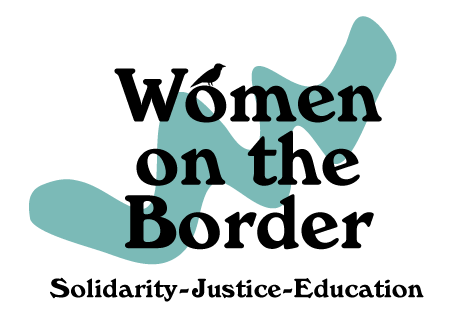What We are Reading Now
Reviews by Jess Chapin
Lost Children Archive, by Valeria Luiselli
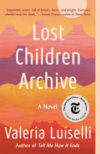
In the back seat of the Volvo station wagon are the man’s son, age 10, and the woman’s daughter, age 5. In addition to their four suitcases, the trunk of the car holds seven file boxes. Four of them are filled with the man’s notebooks, and other research materials. A fifth holds a collection of scholarly and literary texts that the woman has chosen to bring. They have novels by Virginia Woolf and Joseph Conrad, works of criticism and philosophy by Walter Benjamin and Rosalind Krause, primary sources, newspaper clippings, audio books and volumes of ethnomusicology. The other two file boxes are empty. One for each of the children, archives waiting to be filled.
Read more
The first-person narrative voice of the mother dominates the first half of the novel and that of the boy the second, interrupted throughout by a series of Elegies (read from a small red book which the mother has brought on the trip) that chronicles the journey of a group of children traveling with a coyote northward through Mexico and across the border into the Sonoran Desert. As the family drives south and westward, the landscape is filled with echoes and traces of both historical and present tragedy that resonate and interact with the world of ideas stored in the archives that they are already carrying. The novel itself is disjointed, contingent, like the polaroid pictures taken by the boy, which become visible only when placed between the pages of the book of Elegies.
Born in Mexico and raised all over the world, Luiselli is a compelling young writer. Lost Children Archive is a work of fiction that emerged from the advocacy work she did with child migrants in New York City, work that she also writes about in her previously published nonfiction voume Tell Me How It Ends: An Essay in Forty Questions.
Making a Killing: Femicide, Free Trade, and La Frontera, edited by Alicia Gaspar de Alba, with Georgina Guzmán
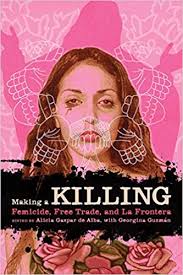
The contributors include legal scholar Elvia Arriola (founder and board member of Women on the Border), whose analysis looks at the disregard for the safety of female bodies that is already embedded in the structure of the export-led industrialization on the Mexican border. She emphasizes the need for feminists concerned about the Juárez femicides to study and to fight for change in the political and economic policies surrounding “free trade.” Melissa Wright’s chapter on “Femicide, Mother-Activism, and the Geography of Protest” analyses the development of women’s public responses to the murders and looks at the ways in which cultural ideas about the “public woman” as a threat to social order have often de-legitimized feminist voices and shaped the emergence of mother-centered forms of protest. Volk and Schlotterbeck examine the ways that the Juárez murders have inspired cultural production both on the border and beyond, from Carlos Fuentes to Los Tigres del Norte. They argue that many of these representations ultimately re-victimize the women by deploying patriarchal narratives of female vulnerability. They highlight instead resistant voices that are centered on female agency and the assertion of full citizenship.
From academics to artists and even a professional criminologist, the contributors take a variety of approaches to analyzing the social and economic context in which the murders of women continue to take place and trying to understand how social justice work in Ciudad Juárez can be effective.
Borderwall as Architecture: A Manifesto for the U.S.-Mexico Boundary, by Ronald Rael
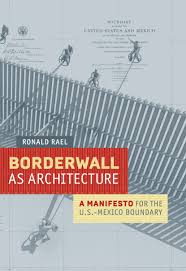
While much of its focus is on the technologies and techniques developed by those dedicated to securing the border and those determined to circumvent it — from simple wooden catapults and ladders to complex surveillance systems and networks of tunnels, it is principally a call to transform an infrastructure of fear, exclusion, and death into one of collaboration, compassion, and hope. Borderwall as Architecture is a wonderfully illustrated book, filled with maps, photographs, and architectural drawings, as well as short pieces by other academics, artists, and activists.
Rael offers multiple ways to think differently about the border wall: as the foundation for an east-west bicycle and pedestrian path, a system for converting Pacific fog into potable water, and as solar energy infrastructure. He presents his own ideas as well as examples from the work of others, Rael suggests uses of the steel barrier as a volleyball net, a binational yoga studio, a confessional, a xylophone, a burrito stand, or as the fulcrum for a pink iron see saw on which children and adults from both sides of the border can play. He writes: “Perhaps the best way to represent the mutually dependent relationship between the United States and Mexico is through the construction of a Teeter-Totter Wall. … a symbolic and literal fulcrum for U.S.-Mexico relations.”
To learn more about Ronald Rael’s work and watch a short film about his work at the border, go to borderwallasarchitecture.com.
Recommended Reading
Women & Globalization Bibliography
Maria Patricia Fernandez-Kelly. For We are Sold, I and My People: Women and Industry in Mexico’s Frontier. Albany: State University of New York Press, 1983.
Annette Fuentes & Barbara Ehrenreich. Women in the Global Factory. Boston: South End Press, 1983.
Norma Iglesias Prieto. Beautiful Flowers of the Maquiladora: Life Histories of Women Workers in Tijuana (Michael Stone & Gabrielle Winkler, trans.). Austin: University of Texas Press, 1997. (first published as: La Flor Mas Bella de la Maquiladora: Historias de Vida de la Mujer Obrera en Tijuana. Mexico City: Centro de Educacion Publica and Centro de Estudios Fronterizos del Norte de Mexico, 1985.)
Leslie Sklair. Assembling for Development: The Maquila Industry in Mexico and the United States. San Diego: UCSD Center for U.S.-Mexican Studies, 1993.
Susan Tiano. Patriarchy on the Line: Labor, Gender, and Ideology in the Mexican Maquila Industry. Philadelphia: Temple University Press, 1994.
Devon G. Pena. The Terror of the Machine: Technology, Work, Gender, & Ecology on the U.S.-Mexico Border. Austin: UT Center for Mexican American Studies, 1997.
Rachel Kamel & Anya Hoffman (eds.). The Maquiladora Reader: Cross-Border Organizing Since NAFTA. Philadelphia: American Friends Service Committee, 1999.
Comité Fronterizo de Obreras. Six Years of NAFTA: A View From Inside the Maquiladoras. Seis Años de TLC. Piedras Negras, Coahuila & Philadelphia, PA: CFO in cooperation with Mexico-U.S. Border Program, American Friends Service Committee, Oct. 1999.
Martha A. Ojeda & Rosemary Hennessy (eds.). NAFTA From Below: Maquiladora Workers, Farmers, and Indigenous Communities Speak Out on the Impact of Free Trade in Mexico. Laredo: Coalition for Justice in the Maquiladoras, 2006.
Carolyn Tuttle. Mexican Women in American Factories: Free Trade and Exploitation at the Border. Austin: University of Texas Press, 2012.
Nina Ebner & Mateo Crossa. “Maquiladoras and the Exploitation of Migrants on the Border.” NACLA (website), October 11, 2019.
Migrants & Human Rights Bibliography

______. Blockading the Border and Human Rights: The El Paso Operation that Remade Immigration Enforcement. Austin: University of Texas Press, 2010.
Denise A. Segura & Patricia Zavella, eds. Women and Migration in the U.S.- Mexico Borderlands: A Reader. Durham: Duke University Press, 2007.
Christine Kovic. “Searching for the Living, the Dead, and the New Disappeared on the Migrant Trail in Texas: Preliminary Report on Migrant Deaths in South Texas.” Houston: Prvention of Migrant Deaths Working Group of Houston United/Houston Unido, May, 2013.
Aviva Chomsky. Undocumented: How Immigration Became Illegal. Boston: Beacon Press, 2014.
Jason De León. The Land of Open Graves: Living and Dying on the Migrant Trail. Oakland: University of California Press, 2015.
Valeria Luiselli. Tell Me How It Ends: An Essay in Forty Questions. Minneapolis: Coffee House Press, 2017.
Elvia L. Arriola & Virginia M. Raymond. “Migrants Resist Systemic Discrimination and Dehumanization in Private, For Profit Detention Centers,” 15 Santa Clara Journal of International Law, 1, 2017.
Jeremy Slack. Deported to Death: How Drug Violence is Changing Migration on the US-Mexico Border. Oakland: University of California Press, 2019.
César Cuauhtémoc Garcia Hernández. Migrating to Prison: America’s Obsession With Locking Up Immigrants. NY: The New Press, 2019.
Roxanne Dunbar-Ortiz, Not a Nation of Immigrants: Settler Colonialism, White Supremacy and a History of Erasure and Exclusion, Beacon Press 2021.
Katherine Fobear. “Addressing Central and South American LGBTQ Asylum Seekers,” Georgetown Journal of International Affairs, Nov. 16, 2021.
Borderlands Bibliography

Josiah McC. Heyman. Life and Labor on the Border: Working People of Northeastern Sonora, Mexico, 1886-1986. Tucson: University of Arizona Press, 1991.
Debbie Nathan. Women and Other Aliens Essays From the U.S.-Mexico Border. El Paso: Cinco Puntos Press, 1991.
Daniel D. Arreola & James R. Curtis. The Mexican Border Cities: Landscape Anatomy and Place Personality. Tucson: University of Arizona Press, 1993.
Luis Alberto Urrea. Across the Wire: Life and Hard Times on the Mexican Border. New York: Anchor Books, 1993.
_______. By the Lake of Sleeping Children: The Secret Life of the Mexican Border. New York: Anchor Books, 1996.
_______. The Devil’s Highway. New York: Little Brown, 2004.
Guillermo Gomez-Peña, New World Boder: Prophecies, Poems & Loqueras for the End of the Century. San Francisco: City Lights, 1996.
Scott Michaelsen & David E. Johnson (eds.). Border Theory: The Limits of Cultural Politics. Minneapolis: University of Minnesota Press, 1997.
Charles Bowden. Juarez, the Laboraotory of Our Future. Reading, PA: Aperture, 1998.
Pablo Vila. Crossing Borders/Reinforcing Borders: Social Categories, Metaphors, and Narrative Identities on the U.S.-Mexico Frontier. Austin: University of Texas Press, 2000.
_______ (ed.). Ethnography at the Border. Minneapolis: University of Minnesota Press (Cultural Studies of the Americas, Vol.13), 2003.
Kathleen Staudt & Irasena Coronado. Fronteras No Mas: Toward Social Justice at the U.S.-Mexico Border, Palgrave MacMillan US, 2002.
Fernando Romero. Hyper-Border: The Contemporary U.S. Mexico Border and Its Future. Princeton: Princeton Architectural Press, 2007.
Ronald Rael. Borderwall as Architecture: A Manifesto for the U.S.-Mexico Boundary. Oakland: University of California Press, 2017.
Howard Campbell. Downtown Juárez: Underworlds of Violence and Abuse. Austin: University of Texas Press, 2021. (Review by Guadalupe Correa-Cabrera in nacla.)
Readings on the Ciudad Juarez Femicides
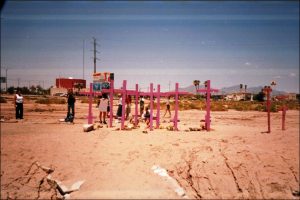
Debbie Nathan. “Missing the Story,” (film review of Senorita Extraviata). Texas Observer, August 30, 2002.
Diana Washington Valdez. The Killing Fields: Harvest of Women, The Truth About Mexico’s Bloody Border Legacy. Peace at the border, 2006.
William Paul Simmons. “Remedies for Women Of Ciudad Juarez Through the Inter-American Court of Human Rights,” Northwest Journal of International Human Rights, Vol.4, Issue 3, Spring 2006.
Kathleen Staudt. Violence and Activism at the Border: Gender, Fear and Everyday Life in Ciudad Juárez. Austin: University of Texas Press, 2008.
Corte Ineramericana de Derechos Humanos. “Caso Gonzalez y Otras (‘Campo Algodonero’) v. Mexico.” Nov. 16, 2009.
Elvia R. Arriola, “La Responsabilidad Por Los Asesinatos en las Maquiladoras: El Vínculo Entre La Indiferencia Empresarial Y La Violencia de Género en la Frontera Entre Estados Unidos y Mexico,” in Daniel Crawford, Coords., Derecho, Democracia Y Economia De Mercado, Bogotá: Universidad de los Andes, 2010.
Alicia Gaspar de Alba & Gorgina Guzmán (eds.). Making a Killing: Femicide, Free Trade, and La Frontera. Austin: University of Texas Press, 2010.
“Inter-American Commission On Human Rights Grants Admissability in Mexican Femicide Case.” Robert F. Kennedy Human Rights (newsletter), Oct. 16, 2017.
“Disappearing Daughters,” a project of the Seattle Times. March 2020.
